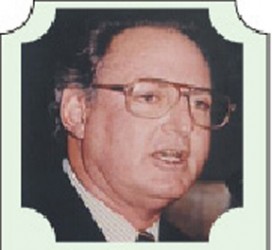By Tony Cozier
THE imminent retirement of Sachin Tendulkar after 24 years accumulating more runs and more hundreds in more international matches than any cricketer in history has revived the constant debate over who is the greatest batsman of his generation.
Is it the little Indian maestro himself, who retires on his own volition after his unparelled 200th Test in his native Mumbai next month?

Or might it not be Brian Lara, the mercurial, typically fete-loving West Indian whose attitude to life was typified by his glittering strokeplay that rendered him the ultimate entertainer yet was conversely allied to a single-minded determination when the mood took him to amass scarcely believable scores?
It was an attribute most obvious when the left-hander reclaimed his Test record 375, made in 1994, just weeks after it had been surpassed ten years later; for good measure he made it an even, unbeaten 400.
Such arguments make sport what it is. The Tendulkar-Lara question mirrors the most prominent in other disciplines.
Rocky Marciano or Joe Louis? Sugar Ray Leonard or Roberto Duran? Bjorn Borg or John McEnroe? Sebastien Coe or Steve Ovett? Arnold Palmer or Jack Nicklaus? The list is as endless as the discussion is heated – and, based on subjective, often biased judgment, as futile.
What is certain is that such rivalries brought the best out of the protagonists. The Leonard-Duran bouts, the Borg-McEnroe matches, the acrimonious Coe-Ovett middle-distance rivalry and all the others have become part of sport’s folklore.
Roger Federer and Rafael Nadal, Novak Djokovic and Roger Murray are currently providing the same excitement on the tennis courts.
Inexplicably, no such compelling competition developed between Tendulkar and Lara when pitted against each other in Tests and ODIs. The proviso, of course, is that cricket is a team, not individual, sport.
Even so, their matches between India and the West Indies were at the same venues under the same conditions. As such, their head-to-head details present an interesting study.
Not once in the 13 Tests (through injuries, Lara missed the 2002-03 tour of India, Tendulkar the 2006 tour of the West Indies) and 41 ODIs they played against each other did they match each other with a hundred.
Of Tendulkar’s 51 Test tons, three were in his 19 matches against the West Indies; Lara’s 34 include just two in 17 against India. Out of his 49 ODI hundreds, Tendulkar managed four in 39 against the West Indies; of Lara’s 19 none was in his 42 matches against India.
There were extenuating circumstances but neither of the two batting superstars prospered in the other’s backyard.
Lara played only three Tests in India, on the 1997 tour; his 91 in the final match at Mohali was his best score (it might have been a hundred but he walked for a catch at the wicket even as umpire Venkataraghavan appeared unlikely to raise his finger).
Tendulkar’s lone hundred in 10 Tests and six ODIs in the Caribbean was 117 at the Queen’s Park Oval in 1997, an innings that was followed by scores of 0, 0, 8 and 0.
So what can be read from such stats? Do they mean that, even in a team environment, egos were a factor, each striving too hard to outdo the other?
Probably not. Uncanny coincidence seems a more plausible reason except both found no difficulty chalking up three figures at the time time as some of the premier batsmen of the day had done so for the opposition.
As a random selection, Lara matched hundreds by Steve Waugh, Ricky Ponting, Graeme Smith, Jacques Kallis (all three times) with ones of his own. Tendulkar’s register includes Matthew Hayden, Mahela Jayawardene (three times), Ponting, Sanath Jayasuriya and Mohammed Yousaf.
There is no doubt, as Sir Garry Sobers noted in a recent interview in an Indian publication, that it is impossible to properly compare sporting icons of different era.
Putting the case for Tendulkar’s run-hungry predecessor, Sunil Gavaskar, as the best Indian batsman he had seen, Sobers made the point that conditions have vastly changed with time.
At the time Gavaskar, and others from the even more distant past such as Don Bradman and Denis Compton (and, of course, Sobers himself) were piling on the runs with the same avarice as Tendulkar and Lara have done, he noted that “there were no restrictions on the number of bouncers per over, bowlers delivered from two yards closer under the old back-foot no-ball rule, the field was set by the players and not by rules, there were no helmets and arm guards and the wickets were uncovered”.
There are clearly all valid points. But Tendulkar and Lara are from the same era so judgments on them can’t be so compromised. Whether or not there is anything to be taken from the fact that they were not at their best when pitted against each other is simply another factor in what is an always lively debate.
West Indians engaged in it would no doubt note the obvious irony that Tendulkar’s specially arranged farewell match should be against their team.
My fellow columnist, Fazeer Mohammed, acknowledged the general dissatisfaction when the celebrated Indian chose to opt out of his country’s tour of the West Indies’ in 2011, preferring rest and relaxation prior to the summer’s series in England.
It was seen, Fazeer wrote at the time, as “a resounding slap across the face of West Indies cricket, the sting of which will linger for some time.
“While not controversial, (it) certainly reinforces how low is the regard for the regional side as reputable opponents and a team against whom notable achievements can stand up as worthy of being considered world-class,” he accurately observed.
It is not difficult to conclude that it is same reason the West Indies have now been invited to be guests at Tendulkar’s grand farewell.
The pity of it is that Lara won’t be in the opposition ranks. His retirement, spectacularly low-key and not of his own choosing, came six years ago; if he is at the Wankedhede Stadium in Mumbai, as he should be, it would be purely for the party.





